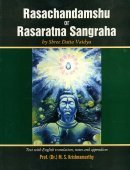Somala: 11 definitions
Introduction:
Somala means something in Hinduism, Sanskrit, Marathi. If you want to know the exact meaning, history, etymology or English translation of this term then check out the descriptions on this page. Add your comment or reference to a book if you want to contribute to this summary article.
In Hinduism
Ayurveda (science of life)
Rasashastra (Alchemy and Herbo-Mineral preparations)
Source: Wisdom Library: Rasa-śāstraSomala (सोमल) is a Sanskrit technical term corresponding to “Arsenic oxide”. It is commonly used in Rasaśāstra literature (Medicinal Alchemy) such as the Rasaprakāśasudhākara or the Rasaratna-samuccaya. Somala is an ingredient often used in various Ayurvedic recipes and Alchemical preparations.

Āyurveda (आयुर्वेद, ayurveda) is a branch of Indian science dealing with medicine, herbalism, taxology, anatomy, surgery, alchemy and related topics. Traditional practice of Āyurveda in ancient India dates back to at least the first millenium BC. Literature is commonly written in Sanskrit using various poetic metres.
General definition (in Hinduism)
Source: Google Books: South Indian ShrinesSomala (सोमल):—She was a queen and wife of the Hoysala king Vira-Somesvaradeva.
Languages of India and abroad
Marathi-English dictionary
Source: DDSA: The Molesworth Marathi and English Dictionarysōmala (सोमल).—m sōmalakhāra m ( A) White arsenic.
--- OR ---
sōmaḷa (सोमळ).—a (sōṣma or sōmāla S) Warmish, tepid, slightly warm. 2 (sōmāla S) Tender, delicate, fine; readily susceptible of injury.
--- OR ---
sōmāḷā (सोमाळा).—a (sōmāla S Or from sōmaḷa) Warmish, lukewarm, softly or slightly warm.
Source: DDSA: The Aryabhusan school dictionary, Marathi-Englishsōmala (सोमल).—m White arsenic.
Marathi is an Indo-European language having over 70 million native speakers people in (predominantly) Maharashtra India. Marathi, like many other Indo-Aryan languages, evolved from early forms of Prakrit, which itself is a subset of Sanskrit, one of the most ancient languages of the world.
Sanskrit dictionary
Source: DDSA: The practical Sanskrit-English dictionarySomala (सोमल).—a. Soft, bland, placid (M. W. gives somāla in this sense).
Source: Cologne Digital Sanskrit Dictionaries: Shabda-Sagara Sanskrit-English DictionarySomāla (सोमाल).—mfn.
(-laḥ-lā-laṃ) Soft, bland. E. soma the moon, al to resemble, aff. ac .
Source: Cologne Digital Sanskrit Dictionaries: Benfey Sanskrit-English DictionarySomāla (सोमाल).—properly a [Prakrit] word for Sskr. sukūmāra, Vararuci, ii. 30, ed. Cowell, adj. Soft.
Source: Cologne Digital Sanskrit Dictionaries: Monier-Williams Sanskrit-English DictionarySomāla (सोमाल):—[from soma] mfn. ([according to] to some a Prākṛt corruption for su-kumāra; cf. komala) soft, bland, [cf. Lexicographers, esp. such as amarasiṃha, halāyudha, hemacandra, etc.]
Source: Cologne Digital Sanskrit Dictionaries: Yates Sanskrit-English DictionarySomāla (सोमाल):—[(laḥ-lā-laṃ) a.] Soft, bland.
[Sanskrit to German]
Sanskrit, also spelled संस्कृतम् (saṃskṛtam), is an ancient language of India commonly seen as the grandmother of the Indo-European language family (even English!). Closely allied with Prakrit and Pali, Sanskrit is more exhaustive in both grammar and terms and has the most extensive collection of literature in the world, greatly surpassing its sister-languages Greek and Latin.
Kannada-English dictionary
Source: Alar: Kannada-English corpusSōmala (ಸೋಮಲ):—[noun] arsenic trisulfide, As2S3, having a lemon-yellow colour and a resinous lustre which is used as a pigment; orpiment.
Kannada is a Dravidian language (as opposed to the Indo-European language family) mainly spoken in the southwestern region of India.
See also (Relevant definitions)
Starts with: Somaladevi, Somalaka, Somalakara, Somalakhara, Somalamchana, Somalata, Somalataa, Somalate, Somalatha, Somalatha pacha, Somalathe, Somalatika.
Ends with: Agyasomala, Sankhyasomala, Shankhya Somala.
Full-text (+4): Somalakara, Shankhya Somala, Somaladevi, Somali, Commiphora guidottii, Commiphora staphyleifolia, Thespesia danis, Oldfieldia somalensis, Rhynchosia sublobata, Commiphora rostrata, Rhodopentas bussei, Trichilia emetica, Somapa, Oncocalyx fischeri, Clerodendrum incisum, Tephrosia uniflora, Adansonia digitata, Asparagus africanus, Clerodendrum glabrum, Albuca abyssinica.
Relevant text
Search found 3 books and stories containing Somala, Sōmala, Sōmaḷa, Sōmāḷā, Somālā, Somāla; (plurals include: Somalas, Sōmalas, Sōmaḷas, Sōmāḷās, Somālās, Somālas). You can also click to the full overview containing English textual excerpts. Below are direct links for the most relevant articles:
Later Chola Temples (by S. R. Balasubrahmanyam)
Temples in Purisaikkudi < [Chapter XVIII - Chola-Hoysala Phase]
Temples in Srirangam < [Chapter II - Temples of Kulottunga I’s Time]
The history of Andhra country (1000 AD - 1500 AD) (by Yashoda Devi)
Part 58 - Other Chalukyas < [Chapter XI - The Chalukyas]
Rasa Jala Nidhi, vol 1: Initiation, Mercury and Laboratory (by Bhudeb Mookerjee)
Part 17 - Mercurial operations (15): Killing of mercury (marana) < [Chapter IV-V - Mercurial operations]
Related products
